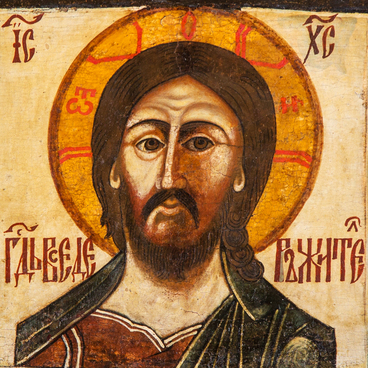The word ‘deesis’ comes from the Greek language and means ‘praying, plea’. This deesis named Templon - ‘Coruna’ of the Holy Doors was made by an unknown artist in the middle of 17th century. The deesis was a part of the templon iconostasis of the Murom Annunciation monastery and was placed right above the Holy Doors. In an Orthodox church a templon is a wooden fixture for the sanctuary screen.
The composition of this deesis consists of 3 separate parts that are placed in border scenes - ‘windows’. The rectangular board is completely shod with various-sized silver and golden plates with large vegetative ornament on them. As an element of church decoration a deesis got widespread in the ancient Russian and Byzantine art since 10-11th centuries.
The main idea of the composition is the Second Coming of Jesus Christ, the Doomsday and the salvation of the humanity after it.
The Lord Almighty arisen for the Judgement is depicted in the center, the Mother of God and John the Baptist are situated on either side of him. They offer intercessory prayers for the human race. Their images have wings and crowns. All the silhouettes are painted on gold with special black paint (a mixture of sulfur and mercury) and a little of cinnabar. Cinnabar is the scarlet-coloured paint derived from mercury.
Besides the traditional iconography of the Deesis the author also used some iconographic elements that refer to the icons Stabat Mater and Divine Wisdom. Such combination cannot be found at any other ancient Russian art monuments. In these scenes Jesus Christ is depicted as The Great Hierarch, and the image of the Mother of God represents the Christian Church.
According to the medieval European traditions The Holy Trinity was usually depicted in the composition centre. In the early 14th century such trend became widespread in the art of the Byzantine world. It was based on Saint Jerome of Stridonium’s theological interpretations of Psalm 109. One of the earliest known examples of this iconographic style in Russia was the vita icon from the Annunciation Cathedral in the Moscow Kremlin.
The main idea of the composition is the Second Coming of Jesus Christ, the Doomsday and the salvation of the humanity after it.
The Lord Almighty arisen for the Judgement is depicted in the center, the Mother of God and John the Baptist are situated on either side of him. They offer intercessory prayers for the human race. Their images have wings and crowns. All the silhouettes are painted on gold with special black paint (a mixture of sulfur and mercury) and a little of cinnabar. Cinnabar is the scarlet-coloured paint derived from mercury.
Besides the traditional iconography of the Deesis the author also used some iconographic elements that refer to the icons Stabat Mater and Divine Wisdom. Such combination cannot be found at any other ancient Russian art monuments. In these scenes Jesus Christ is depicted as The Great Hierarch, and the image of the Mother of God represents the Christian Church.
According to the medieval European traditions The Holy Trinity was usually depicted in the composition centre. In the early 14th century such trend became widespread in the art of the Byzantine world. It was based on Saint Jerome of Stridonium’s theological interpretations of Psalm 109. One of the earliest known examples of this iconographic style in Russia was the vita icon from the Annunciation Cathedral in the Moscow Kremlin.



